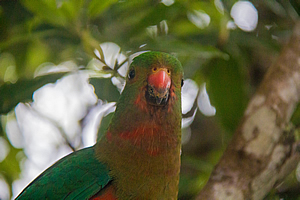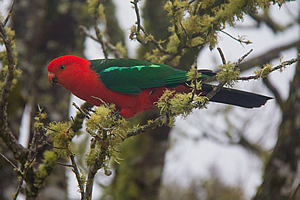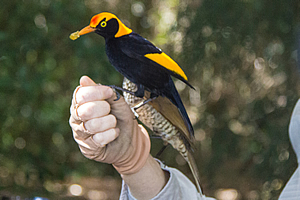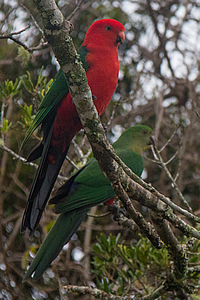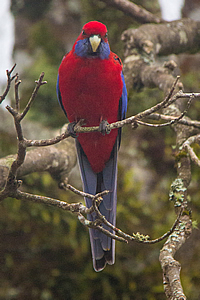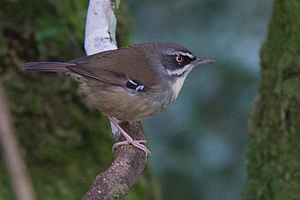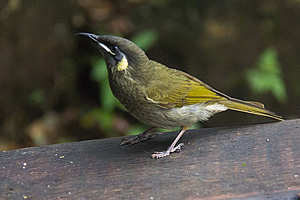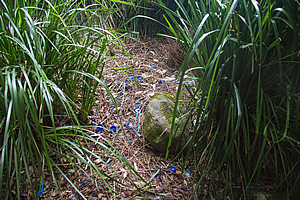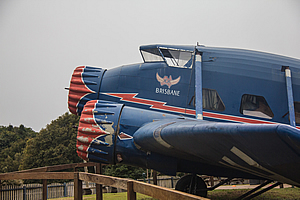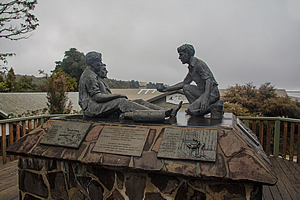--- Archive files ---
Home > Travels > Tweed > 10 |
Above the Volcano
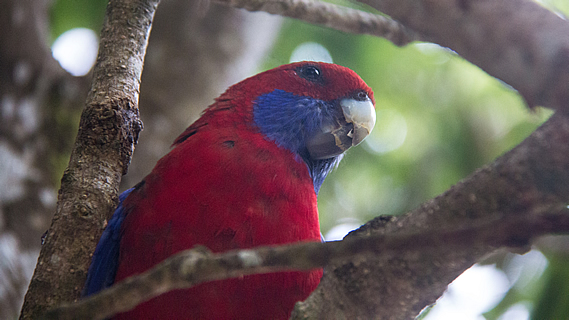
TWO THINGS stand out for me at O’Reillys. The first is the proliferation of brightly coloured parrots. The other is a large replica plane standing on a small knoll. Both of these have a story to tell from skies above the Tweed Volcano.
King Parrot |
The trees throughout much of the park stand too tall for much of the canopy birdlife to be seen from the forest floor where us humans dwell.
The story goes back to the 1930s when the local farmers on the O’Reilly’s plateau found an injured parrot and cared for it. They gradually released it back into the wild as it recovered but they continued to feed it. The parrot told all of its friends in the forest and it was joined by another one, then a few more, and eventually a whole crowd of parrots was coming each morning for feeding.
King Parrot |
This still occurs today, so in the middle of each morning, a large number of parrots congregate from the surrounding forests for feeding. This seemed totally unnatural, but for me it presented some wonderful photo opportunities seeing them in the trees hovering around.
Most of the parrots here are either crimson rosella – a red parrot with bright blue wings, or the king parrot which was red with green wings and back. These birds are very brightly coloured for herbivores. Perhaps this is because they don’t have any natural predators and are therefore unrestrained in showing off their brilliant colours to potential mates. The two varieties were the same size and shape. It was only their colouring that distinguished them.
Bowerbird |
There were a few other bird varieties that also took advantage of the feeding, creating an unnaturally high concentration of birds to keep the tourists happy.
The parrots were very tame and friendly, but there are other birds that remain elusively unseen, but have distinctive calls. One of the most common throughout this region is the Wompoo pigeon. The name is onomatopoeic as it gives off its soft resonant “wompoo” sounds that reverberate around the forest.
King Parrot |
Eastern Rosella |
Not so subtle are the calls of the green catbird. These are almost never seen but they give this most atrocious screech like a cat being strangled. It is an eerie sound to be hearing deep in the jungle, especially as their almost perfect camouflage high in the forest canopy ensures they are almost never seen.
Small forest bird |
Few bird species occupy the dark forest floor. The one notable exception is the mostly flightless brush turkey. This close remnant of the theropod dinosaurs perpetually forages the forest floor in search of bugs to eat. There are a few small species of bird that fly around at the lower levels exploring the forest floor. These are perfectly camouflaged with the brown soil, making them hard to find even when they are erratically flying around the foliage.
Near the feeding area stood a replica of the Stinson, an old twin propeller plane from the 1930s. It used to run regular flights between Brisbane and Sydney, a trip of about 800 kilometres. Modern jets travelling this route ascend to over 9 kilometres well and truly clearing any mountains. These old planes only flew about a kilometre above sea level. The MacPherson Range was the highest land the plane needed to clear, and parts of the crater were higher than its cruising altitude, so it would have to navigate its way across one of the crater’s passes.
Small forest bird |
The plane was just thirteen metres long and had a wingspan of twenty metres. This is tiny by today’s standards but back in 1937 it was an impressive size.
On most days the plane would navigate its way through one of the passes eroded between the plateaus and continue on its journey. This was not the case on 19 February 1937 when one of the Stinson planes encountered a huge storm over the volcano. The turbulence from the storm caused the pilots to drift off course during their attempt to clear the range. It would have been a huge shock to them to have suddenly seen the ancient Antarctic beech trees suddenly appear just below them through the thick swirling mist. With no time to gain altitude a sudden wind shear sent them crashing into the foliage where the plane hurtled through with its wings sheared off before coming to an abrupt stop deep in the unexplored forest. Four of the seven people on board were killed instantly.
Bowerbird's bower |
A search was conducted when the plane failed to reach its destination in Sydney. For a week the search was conducted up and down the coast along the flight path but not a trace was found.
Three of the passengers had survived the initial crash. After several days they realised no one was going to find them, so one of the survivors set off on foot in an attempt to reach civilisation. After several hours of trekking through the thick undergrowth he reached a gully, which he followed downhill until a stream formed. He was now able to drink fresh water, so he continued following the stream. Unfortunately he wasn’t aware that passage is a lot easier along the ridges than it is along the valleys. The gentle gully containing the stream soon became a deep gorge hindering his progress. He was keen to reach help as quickly as possible, but in his haste he fell over the top of a waterfall severely injuring himself.
The Stinson |
A week following the crash local farmer Bernard O’Reilly heard about the crash. He had a hunch about where the wreckage would lie. Given these were the highest mountains along the route between Brisbane and Sydney, and given the big storm a week ago, he presumed it had crashed into the surrounding mountains.
After exploring the ridges along the McPherson Range and spending the night huddling under a tree, Bernard O’Reilly climbed Mount Throakban and saw a burnt tree about eight kilometres away. He quickly headed towards it and was surprised to hear a “coo-ee” three hours later. This was one of the two survivors. Unfortunately they were both severely dehydrated. One had a broken leg and the other was uninjured, so Bernard got a fire going and boiled a billy for them. He got them as comfortable as possible before he returned to the farm alone to get some help. He followed Christmas Creek downstream and found the body of the third survivor at the base of a waterfall. He had not survived his injuries. He returned the following morning with several farmers and a doctor, cutting a path through the forest as they went.
Statue of the survivors of the Stinson |
Upon arriving at the wreck, they buried the bodies of the four who had died (including the two pilots) during the initial impact. They then carried the men out by stretcher through the dense jungle, finally reaching the safety of civilisation a full eleven days after the crash. The story of the Stinson remains in local legend and the original plane remains rusting in its original place in the remote jungle along the tops of the McPherson Range.
Today planes fly several kilometres overhead almost completely eliminating the possibility of a crash in the mountains. The skies are instead dominated by the proliferation of large brightly coloured parrots soaring amongst the tall rainforest canopy.
<< Previous | Next >> |
|
||
About this Page
|
||
|
|
|
Where is Walkabout Jeff? |
|
|
|
|
What is happening in Walkabout Jeff's hometown?
|
|
|
|
|
Who is Walkabout Jeff?Any normal person's idea of going out involves going to the local pub for a drink with a few mates. Walkabout Jeff isn't normal.
|
|
|
|
|
